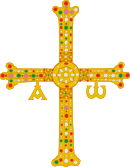San Tirso, Oviedo
- View a machine-translated version of the Spanish article.
- Machine translation, like DeepL or Google Translate, is a useful starting point for translations, but translators must revise errors as necessary and confirm that the translation is accurate, rather than simply copy-pasting machine-translated text into the English Wikipedia.
- Do not translate text that appears unreliable or low-quality. If possible, verify the text with references provided in the foreign-language article.
- You must provide copyright attribution in the edit summary accompanying your translation by providing an interlanguage link to the source of your translation. A model attribution edit summary is
Content in this edit is translated from the existing Spanish Wikipedia article at [[:es:Iglesia de San Tirso (Oviedo)]]; see its history for attribution. - You may also add the template
{{Translated|es|Iglesia de San Tirso (Oviedo)}}to the talk page. - For more guidance, see Wikipedia:Translation.
The Church of Saint Thyrsus (Spanish: Iglesia de San Tirso; or Iglesia de San Tirso el Real de Oviedo) is a Roman Catholic Asturian Romanesque church situated in Oviedo, in Asturias, northern Spain. The church was established in the 790s. Dedicated to Saint Thyrsus, it was built by Tioda, the royal architect of Alfonso II of Asturias. The Great Fire of Oviedo in 1521 and rebuilding in the 18th century removed most of the original church, except for a three-light window.

Building
The building has suffered so much from alterations over the centuries and only the general plan has been preserved. It is that of a basilica with nave and aisles divided by rude stone piers set at unequal intervals, from which round arches spring. In the easternmost bay, however, owing to the smaller span, the arch was made sufficiently pointed to raise its crown to the same height as the others. This irregularity was already typical of Imperial Roman times, when barrel vaults were given a pointed form in order to make the height of rooms of varying size uniform, as it was necessary to raise the crown of the vault in some of them. This is illustrated by various chambers in the House of Tiberius on the Palatine.[1]
There is no satisfactory explanation of the "many angels" the building is said to have presented in the Codex Vigilianus.
In the rectangular sanctuary atriplet round-arched window (2 by 2 metres (6.6 ft × 6.6 ft) is preserved. With its pre-romanesque bases, rough brick arches, and capitals with rude packed leaves, it gives an idea of the better style of building and carving in the time of Alfonso II of Asturias. It is known that the church of San Tirso housed Royal Chapel.[2]
See also
- Asturian architecture
- Catholic Church in Spain
Notes
- ^ Rivoira 1918, p. 335
- ^ Redondo Cadenas 1975, p. 609
References

- Redondo Cadenas, Feliciano (1974). "La iglesia de San Tirso el Real de Oviedo I: su pasado y presente" (PDF). Boletin del Insituto de Estudios Asturianos (in Spanish). 29 (81): 171–183. ISSN 0020-384X. Archived from the original (PDF) on 2014-10-31.
- Redondo Cadenas, Feliciano (1975). "La iglesia de San Tirso el Real de Oviedo II: basílica primitiva" (PDF). Boletin del Insituto de Estudios Asturianos (in Spanish). 30 (88–89): 607–626. ISSN 0020-384X. Archived from the original (PDF) on 2014-10-31.
- Redondo Cadenas, Feliciano (1976). "La iglesia de San Tirso el Real de Oviedo III: La torre y sus alrededores" (PDF). Boletin del Insituto de Estudios Asturianos (in Spanish). 31 (90–91): 343–362. ISSN 0020-384X. Archived from the original (PDF) on 2014-10-31.
- Rivoira, Giovanni Teresio (1918). "Moslem architecture: its origins and development". London: Oxford University Press.
{{cite journal}}: Cite journal requires|journal=(help)
- v
- t
- e
- Pre-Romanesque art in Asturias is framed between the years 711 and 925, the period of the rise and extension of the Kingdom of Asturias.
| 1st period (737 to 791) | |
|---|---|
| 2nd period (791 to 842) | |
| 3rd period (842 to 866) | |
| 4th period (866 to 910) | |
| 5th period (910 to 925) |















